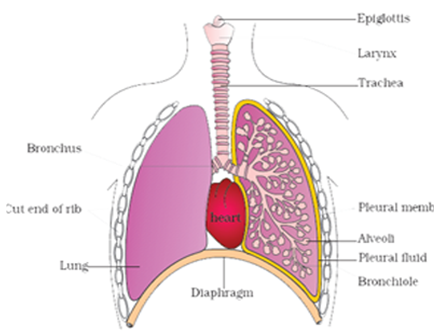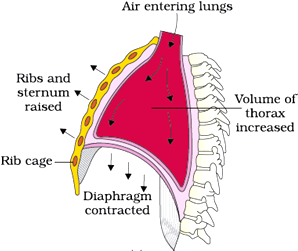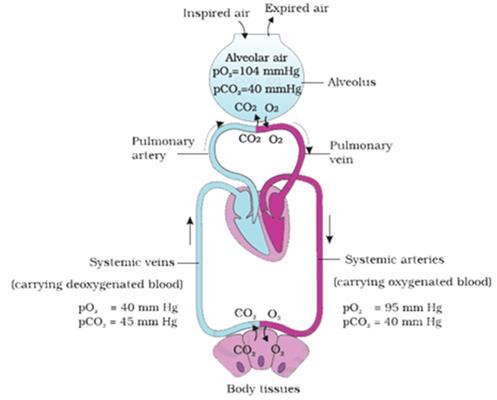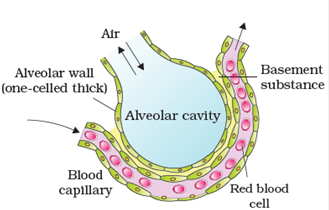Breathing and Exchange of Gases - Revision Notes
CBSE Quick Revision Notes
CBSE Class-11 Biology
CHAPTER-17
BREATHING AND EXCHANGE OF GASES
The process of exchange of O2 from the atmosphere with CO2 produced by the cell is called breathing. It occurs in two stages of inspiration and expiration. During inspiration air enters the lungs from atmosphere and during expiration air leaves the lungs.
Breathing | Respiration |
a. It is simply an intake of fresh air and removal of foul air. b. It is a physical process. c. No energy is released. d. It is an extracellular process. | a. It is the oxidation of food to form carbon dioxide, water and energy. b. It is a biochemical process. c. Energy is released in form of ATP. d. It is an intracellular process. |
Respiratory Organs – Mechanism of breathing varies in different organism according to their body structure and habitat.
Respiratory Organs | Organisms |
Entire Body surface | Sponges, coelenterate, flatworms. |
Skin | Earthworm. |
Tracheal system | Insects |
Gills | Pisces, aquatic arthropods. |
Lungs | Amphibians, mammals. |
Human Respiratory System
- Human respiratory system consists of a pair of nostrils, pharynx, larynx, bronchi and bronchioles that finally terminates into alveoli.
- Nasal chamber open into pharynx that leads to larynx. Larynx contains voice box (sound box) that help in sound production.
- The trachea, primary, secondary and tertiary bronchi and initial bronchioles are supported by incomplete cartilaginous rings to prevent collapsing in absence of air.
- Each bronchiole terminates into an irregular walled, vascularized bag like structure called alveoli.

- The branching network of bronchi, bronchioles and alveoli collectively form the lungs.
- Two lungs are covered with double layered pleura having pleural fluid between them to reduce the friction on lung surface.

- Conducting parts include nostrils, pharynx, larynx and trachea. Main functions include-
- Transport of atmospheric air to alveoli.
- Removing foreign particles from air, humidifying it and bringing it to body temperature.
- The exchange parts are alveoli. It is the site of actual diffusion of and C between blood and atmospheric air.
Steps of Respiration
- Breathing in which Oxygen rich atmospheric air is diffused in and C rich alveolar air is diffused out.
- Diffusion of gases across alveolar membrane.
- Transport of gases by blood.
- Diffusion of and C between blood and tissues.
- Utilization of by cells to obtain energy and release of C (cellular respiration).
Mechanism of Breathing
- Breathing involves inspiration and expiration. During inspiration atmospheric air is drawn in and during expiration, alveolar air is released out.
- Movement of air in and out takes place due to difference in pressure gradient.
- Inspiration occurs when pressure inside the lung is less and expiration occurs when pressure is more in lungs than outside.
- The diaphragm and external and internal intercostal muscles between the ribs help in developing pressure gradient due to change in volume.

- The contraction of intercostal muscles lifts the ribs and sternum causing an increase in volume of thoracic cavity that results in decrease in pressure than the atmospheric pressure. This causes inspiration.
- Relaxation of the diaphragm and intercostal muscles reduce the thoracic volume and increase the pressure causing expiration.
- The volume of air involved in breathing movements is estimated by using spirometer for clinical assessment of pulmonary functions.

Respiratory Volume and Capacities
Tidal volume (TV) - volume of air inspired or expired during a normal respiration. It is about 500mL in healthy man.
Inspiratory Reserve Volume (IRV) – additional volume of air a person can inspire by forceful inspiration. It is about 2500 mL to 3000mL.
Expiatory Reserve Volume (ERV) – additional volume of air a person can expire by forceful expiration. It is about 1000 mL to 1100mL.
Residual Volume (RV) - volume of air remaining in lungs even after a forcible expiration. It is about 1100mL to 1200mL.
Inspiratory Capacity (IC) - TV + IRV
Expiratory Capacity (EC) – TV + ERV
Functional Residual Capacity (FRC) - ERV + RV
Vital Capacity (VC) - maximum volume of air a person can breathe in after a forceful expiration. ERV+ TV+ IRV
Total Lung Capacity (TLC) - total volume of air accommodated in lung at the end of forced inspiration. RV+ ERV+ TV+ IRV or Vital capacity + Residual Volume.

Exchange of Gases
- Exchange of gases takes place at two sites
- Alveoli to blood
- Between blood and tissues.
- Exchanges of gases occur by simple diffusion due to pressure/ concentration gradient, solubility of the gases and thickness of membrane.
- Pressure contributed by individual gas in a mixture of gas is called partial pressure represented by pC and p .
- Partial pressure of Oxygen and carbon dioxide at different part involved in diffusion varies from one part to another and moves from higher partial pressure to lower partial pressure.
- Solubility of C is 20-25 times more than solubility of , so C diffuse much faster through membrane.
- Diffusion membrane is three layered thick, that is alveolar squamous epithelium, endothelium of alveolar capillaries and basement substance between them.

Transport of Gases
- Blood is the medium of transport for C and . Most of oxygen (97%) is transported through RBC and remaining 3% by blood plasma.
- 20-25% of C is transported by RBC, 70% as bicarbonate and rest 7% in dissolved state by blood plasma.
Transport of Oxygen
- Haemoglobin in RBC combines with to form Oxyhaemoglobin. Each haemoglobin combine with four oxygen molecules.
- Binding of is related with partial pressure of and , hydrogen ion concentration and temperature.
- Percentage saturation of haemoglobin and partial pressure of oxygen forms sigmoid curve (oxygen dissociation curve).
- In the alveoli, p is more and pC is less, less H+ ions concentration and lower temperature favour the binding of with hemoglobin. Where opposite condition in tissues favour the dissociation of Oxyhaemoglobin.
Transport of Carbon dioxide
- Carbon dioxide is transported by haemoglobin as carbamino-haemoglobin. In tissues pC is high and p is less that favour the binding of carbon dioxide with haemoglobin. Opposite condition help in dissociation of carbamino- haemoglobin in alveoli.
- Enzyme carbonic anhydrase help in formation of carbonate ions to transport carbon dioxide.
Regulation of Respiration
- Human beings have ability to maintain and moderate the rate of respiration to fulfill the demand of body tissues by neural system.
- Respiratory rhythm centre is located in medulla region of hind brain. Pneumotaxic centre in pons moderate the function of respiratory rhythm centre.
- Chemo-sensitive area near rhythm centre is highly sensitive to C and H+ ions that ultimately control the respiratory rate. Oxygen do not play major role in controlling rate of respiration.
Functions of Respiration-
- Energy production
- Maintenance of acid-base balance.
- Maintenance of temperature
- Return of blood and lymph.
Mountain Sickness is the condition characterised by the ill effect of hypoxia (shortage of oxygen) in the tissues at high altitude commonly to person going to high altitude for the first time.
Symptoms-
- Loss of appetite, nausea, and vomiting occurs due to expansion of gases in digestive system.
- Breathlessness occurs because of pulmonary oedema.
- Headache, depression, disorientation, lack of sleep, weakness and fatigue.
Disorder of Respiratory System
- Asthma- it is due to allergic reaction to foreign particles that affect the respiratory tract. The symptoms include coughing, wheezing and difficulty in breathing. This is due to excess of mucus in wall of respiratory tract.
- Emphysema- is the inflation or abnormal distension of the bronchioles or alveolar sacs of lungs. This occurs due to destroying of septa between alveoli because of smoking and inhalation of other smokes. The exhalation becomes difficult and lung remains inflated.
- Occupational Respiratory Disorders- occurs due to occupation of individual. This is caused by inhalation of gas, fumes or dust present in surrounding of work place. This includes Silicosis, Asbestoses due to exposer of silica and asbestos. The symptom includes proliferation of fibrous connective tissue of upper part of lung causing inflammation.
- Pneumonia- it is acute infection or inflammation of the alveoli of the lungs due to bacterium streptococcus pneumoniae. Alveoli become acutely inflamed and most of air space of the alveoli is filled with fluid and dead white blood corpuscles limiting gaseous exchange.